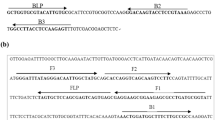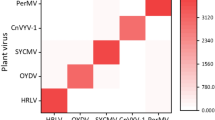Abstract
We developed a self-priming compartmentalization (SPC) micro-device made of polymethyl methacrylate (PMMA) and integrated a loop-mediated isothermal amplification (LAMP) system for performing multiplex visual detection. The approach had a high throughput of identification of selectable marker gene (SMG) (phosphomannose isomerase (PMI) gene, hygromycin B phosphotransferase (HPT) gene, noglycoside phosphotransferase II (NPTII), β-glucuronidase (GUS), and CP4-5-enolpyruvylshikimate-3-phosphate synthase (CP4-EPSPS)) and was able to perform five SMG analyses simultaneously within 1 h. This micro-device can detect five SMGs in one injection, each gene is repeated three times, and each micro-reactor arrays without cross-contamination. The method of extracting genomic DNA from GM rice grains can be very simple and the detection method only requires cell homogenization. In addition, the limit of detections of the method for PMI, HPT, and NPTII were 10−4. The limit of detections of the method for GUS and CP4-EPSPS were 10−5. The results demonstrated that our method could specifically recognize in genetically modified crops.





Similar content being viewed by others
References
Bai SL et al (2010) Detection of six genetically modified maize lines using optical thin-film biosensor chips. Journal of Agricultural and Food Chemistry 58:8490–8494
Bhatia SN, Ingber DE (2014) Microfluidic organs-on-chips. Nature Biotechnology 32:760. https://doi.org/10.1038/nbt.2989
Chaouachi M, Zellama MS, Nabi N, Ben Hafsa A, Said K (2014) Molecular identification of four genetically modified maize (Bt11, Bt176, Mon810 and T25) by duplex quantitative real-time PCR. Food Analytical Methods 7:224–233
Corbisier P, Bhat S, Partis L, Rui Dan Xie V, Emslie KR (2010) Absolute quantification of genetically modified MON810 maize (Zea mays L.) by digital polymerase chain reaction. Analytical and Bioanalytical Chemistry 396:2143–2150. https://doi.org/10.1007/s00216-009-3200-3
Cottenet G, Blancpain C, Sonnard V, Chuah PF (2019) Two FAST multiplex real-time PCR reactions to assess the presence of genetically modified organisms in food. Food Chemistry 274:760–765. https://doi.org/10.1016/j.foodchem.2018.09.050
Dobnik D, Spilsberg B, Kosir AB, Stebih D, Morisset D, Holst-Jensen A, Zel J (2018) Multiplex droplet digital PCR protocols for quantification of GM maize events. In: Digital PCR: methods and protocols, vol 1768. Methods in Molecular Biology. pp 69-98
Dou M, Dominguez DC, Li X, Sanchez J, Scott G (2014) A versatile PDMS/paper hybrid microfluidic platform for sensitive infectious disease diagnosis. Analytical Chemistry 86:7978–7986
El-Ali J, Sorger PK, Jensen KF (2006) Cells on chips. Nature 442:403–411. https://doi.org/10.1038/nature05063
Eugster A, Murmann P, Kaenzig A, Breitenmoser A (2014) Development and validation of a P-35S, T-nos, T-35S and P-FMV tetraplex real-time PCR screening method to detect regulatory genes of genetically modified organisms in food. CHIMIA International Journal for Chemistry 68:701–704. https://doi.org/10.2533/chimia.2014.701
Fernandez S et al (2005) Quantification of the 35S promoter in DNA extracts from genetically modified organisms using real-time polymerase chain reaction and specificity assessment on various genetically modified organisms, part I: operating procedure. Journal of Aoac International 88:547–557
Gansen A, Herrick AM, Dimov IK, Lee LP, Chiu DT (2012) Digital LAMP in a sample self-digitization (SD) chip. Lab on a Chip 12:2247–2254
James (2017) Global status of commercialized biotech/GM crops in 2017: biotech crop adoption surges as economic benefits accumulate in 22 years. ISAAA ISAAA Brief No. 53. ISAAA: Ithaca, NY
Jang H, Kwak CH, Kim G, Kim SM, Huh YS, Jeon TJ (2016) Identification of genetically modified DNA found in Roundup Ready soybean using gold nanoparticles. Microchimica Acta 183:2649–2654
Jinxia A, Qingzhang L, Xuejun G, Yanbo Y, Lu L, Minghui Z (2011) A multiplex nested PCR assay for the simultaneous detection of genetically modified soybean, maize and rice in highly processed products. Food Control 22:1617–1623. https://doi.org/10.1016/j.foodcont.2011.03.018
Khandurina J, McKnight TE, Jacobson SC, Waters LC, Foote RS, Ramsey JM (2000) Integrated system for rapid PCR-based DNA analysis in microfluidic devices. Analytical Chemistry 72:2995–3000
Kiddle G et al. (2012) GMO detection using a bioluminescent real time reporter (BART) of loop mediated isothermal amplification (LAMP) suitable for field use. Bmc Biotechnol 12
Liu L, Xu Y, Zhong W, Li L, Li W, Xiao Q (2019) Comparison of three terminal detection methods based on loop mediated isothermal amplification (LAMP) assay for spring viremia of carp virus (SVCV). Turkish Journal of Fisheries and Aquatic Sciences 19:805–816
Mark D, Haeberle S, Roth G, von Stetten F, Zengerle R (2010) Microfluidic lab-on-a-chip platforms: requirements, characteristics and applications. Chem Soc Rev 39:1153–1182
Mei X et al (2019) Development and application of a visual loop-mediated isothermal amplification combined with lateral flow dipstick (LAMP-LFD) method for rapid detection of Salmonella strains in food samples. Food Control 104:9–19
Meric S, Cakir O, Turgut-Kara N, Ari S (2014) Detection of genetically modified maize and soybean in feed samples. Genetics and Molecular Research 13:1160–1168
Murray MG, Thompson WF (1980) Rapid isolation of high molecular-weight plant DNA. Nucleic Acids Research 8:4321–4325
Notomi T, Okayama H, Masubuchi H, Yonekawa T, Watanabe K, Amino N, Hase T (2000) Loop-mediated isothermal amplification of DNA. Nucleic Acids Research 28
Oh SJ et al (2016) Fully automated and colorimetric foodborne pathogen detection on an integrated centrifugal microfluidic device. Lab on a Chip 16:1917–1926
Pang B et al (2017) Rapid and quantitative detection of Vibrio parahemolyticus by the mixed-dye-based loop-mediated isothermal amplification assay on a self-priming compartmentalization microfluidic chip. Journal of Agricultural and Food Chemistry 65:11312–11319
Shen F et al (2011) Multiplexed quantification of nucleic acids with large dynamic range using multivolume digital RT-PCR on a rotational SlipChip tested with HIV and hepatitis C viral load. Journal of the American Chemical Society 133:17705–17712
White AK et al (2011) High-throughput microfluidic single-cell RT-qPCR. Proceedings of the National Academy of Sciences of the United States of America 108:13999–14004
Yun Z et al (2017) Auto-microfluidic thin-film chip for genetically modified maize detection. Food Control 80:360–365. https://doi.org/10.1016/j.foodcont.2017.03.035
Acknowledgments
The authors thank Prof. Guozhen Liu for providing GM rice.
Funding
This study was funded by a key scientific and research project grant funded by the Science and Technology Bureau of Hebei Province (grant number 17275505D).
Author information
Authors and Affiliations
Corresponding author
Ethics declarations
Conflict of Interest
All authors declare that they have no conflict of interest.
Ethical Approval
This article does not contain any studies with human or animal subjects.
Informed Consent
Not applicable.
Additional information
Publisher’s Note
Springer Nature remains neutral with regard to jurisdictional claims in published maps and institutional affiliations.
Electronic Supplementary Material
ESM 1
(DOCX 18 kb)
Rights and permissions
About this article
Cite this article
Ding, G., Jin, Z., Zhang, Y. et al. Detection of Genetically Modified Rice by Loop-Mediated Isothermal Amplification Assays on a Self-Priming Compartmentalization Chip. Food Anal. Methods 13, 1454–1461 (2020). https://doi.org/10.1007/s12161-020-01766-8
Received:
Accepted:
Published:
Issue Date:
DOI: https://doi.org/10.1007/s12161-020-01766-8




